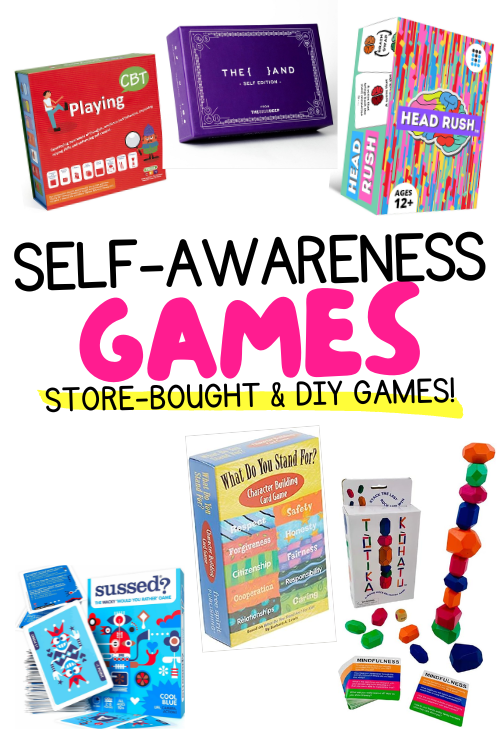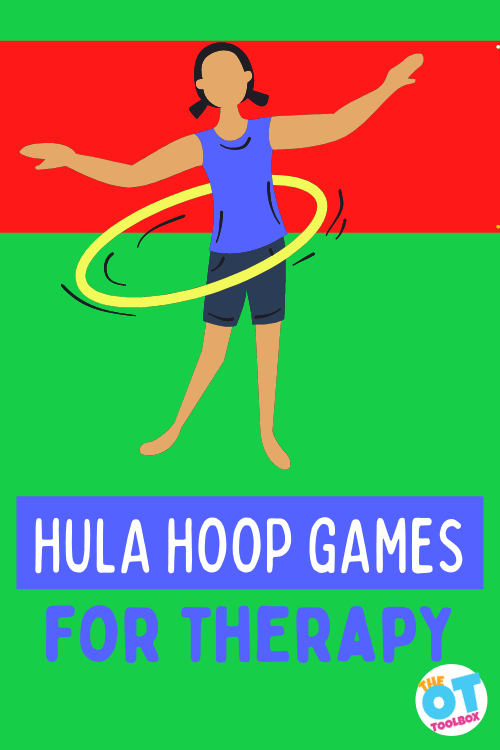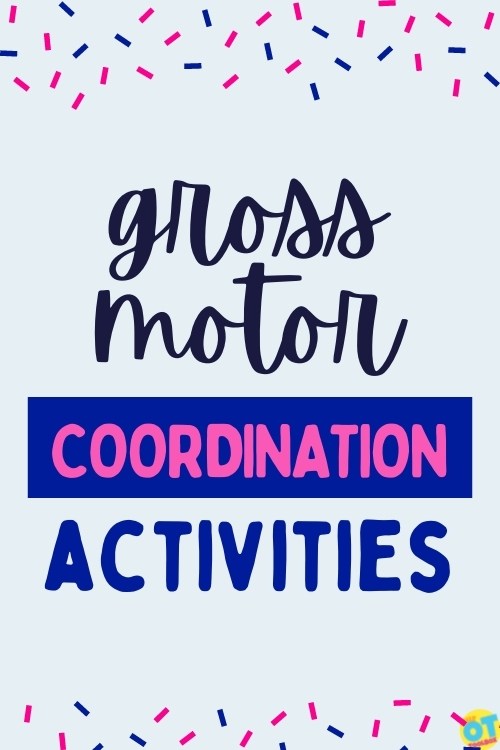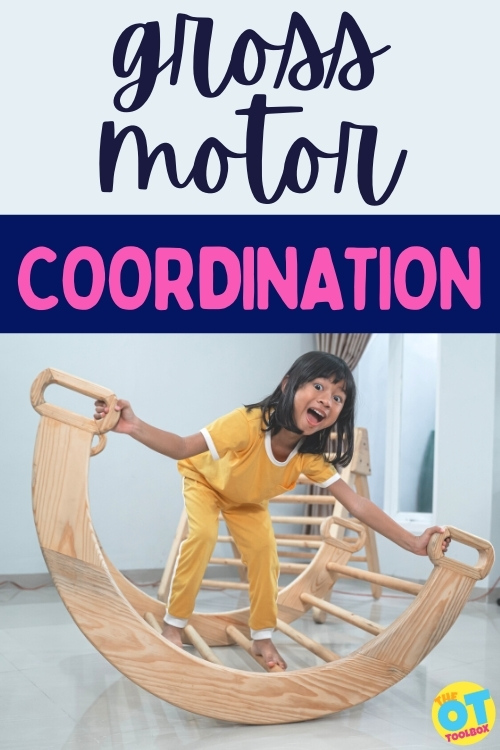In this blog post, we’re covering all things self awareness games. We have previously covered aspects of self-reflection, and these self-awareness games are the perfect fit if you are looking for activities to support this social and emotional development skill. Self-awareness plays a major role in self-regulation skills and knowing when and how to implement self regulation strategies that support the individual’s needs.

“Do you want to be happier, have more influence, be a better decision-maker, and be a more effective leader? Self-awareness, then, is the most important muscle you need to develop. It’s what will keep you on target to be the best version of yourself and the best leader you can be.” I love this excerpt from the Better Up website. It seems like a great sales pitch for self awareness, and makes me want to get in on it! Can you imagine if this was a product to buy, a pill to take, or something that did not require effort and constant adjustment?
Self-Awareness Games
While there is no magic potion for building self awareness, there are some great Self Awareness Games out there to make building this skill more fun. Children and their adult counterparts are more likely to start and stick with something if it is motivating and fun.
Occupational therapy practitioners use tools such as games and play to facilitate the skills needed for functional tasks and independence. Self-awareness games can specifically target the social emotional skills needed for self-reflection, growth mindset, and other aspects of development.
Before we get into the games, let’s cover what self-awareness means.
what is self awareness and what are the benefits?
Self-awareness is more than just and awareness of your your own person. It’s also more than body awareness, or being physically aware of where your body is located in space. However, we might think about self-awareness as an internal mirror.
Psychologists Shelley Duval and Robert Wicklund proposed this definition: “Self-awareness is the ability to focus on yourself and how your actions, thoughts, or emotions do or don’t align with your internal standards.”
Only 10-15% of the population have self awareness. This Self Awareness Test can give you insight into what it means to be self aware.
Self-awareness is an emotional intelligence skill. It’s a skill that facilitates self-regulation.
There are several benefits to having self awareness:
- It gives us the power to influence outcomes
- Self awareness helps us to become better decision-makers
- Awareness of ourselves gives us more self-confidence — so, as a result, we communicate with clarity and intention
- It allows us to understand things from multiple perspective, and frees us from our assumptions and biases
- It helps us build better relationships
- It gives us a greater ability to regulate our emotions
- It empowers us to participate in co-regulation
- It decreases stress, and can make us happier
what to look for when developing self awareness
Self awareness or enlightenment goes beyond just knowing if you are a nice person or not. There are several categories that take part in being aware. These include:
- Being aware of your inner self (feelings, thoughts, voices) A fun feelings check in activity is great for this.
- Awareness of your world view or how life exists and why we are here
- Awareness of your personal beliefs
- Awareness of your inner conflicts
- Awareness of your life values
- Being aware of stress and negativity triggers
- Understanding your own personal limitations
- Identifying self sabotage
- Understanding your “inner parents” (what part of your parents do you carry with you)
- Being clear on thoughts about your goals and future
This sounds like a lot of work and self reflection. It is. Let’s explore some Self Awareness Games that might make this process a little less painful.
All About Me activities supports children in understanding what makes them “tick”. For the younger kids, starting with all about me activities is a great place to start developing an awareness of what makes each person an individual. All About Me preschool activities has some ideas to get you started. You can also use this All About Me PDF for older kids.
self awareness games – store bought
Sometimes you just want to click on a website and order a game rather than trying to make it yourself. This is fine and there are certainly plenty of self awareness games to choose from.
Amazon affiliate links are included below. As an Amazon Influencer, I earn from qualifying purchases.
- The {AND} game self love edition (affiliate link) – “Discover yourself with selfcare and reflection cards, designed to help you discover your true self; With 199 questions and prompts, it encourages you to explore your feelings, beliefs, and experiences, helping you gain a deeper understanding of who you are”. This game is more appropriate for young adults than children.
- Head Rush (affiliate link)- Head Rush requires quick self reflection, and less hesitation, encouraging more revealing answers. Perfect for building rapport and starting meaningful conversations that encourage players to reflect on their feelings, memories, desires and overall self. Appropriate for kids, teens and adults
- The Ultimate CBT game (affiliate link)- 15 games suitable for 7-14 year-olds, based on Cognitive Behavioral Therapy and covering all ABCD model parts. Self-Regulation with Fun – Help them identify their feelings while providing skills to cope with their emotions in a relaxed atmosphere using mindfulness techniques, coping thoughts, breathing techniques, problem solving, etc.
- What do you Stand For Card Game (affiliate link)- this game is based on a book series. This card game spotlights ten top character traits: Caring, Citizenship, Cooperation, Fairness, Forgiveness, Honesty, Relationships, Respect, Responsibility, and Safety.
- Wood Rock Stacking Game (affiliate link)- This game has wooden rocks that need to be stacked. The person who knocks it over loses. There are several versions of this card set, each with a different skills game. Adding a simple game is another way to introduce talking and reflections cards.
- Sussed (affiliate link)- a wacky “Would you Rather” card game – A great icebreaker and educational activity for improving social skills – no matter how old you are! Practice empathy, speaking & listening skills and self-awareness in just 15 minutes of play.
Other ideas include modifying games you already have. You can adapt ready made games with stickers, prompts, etc. You can add reflections and questions to store bought games like Jenga, Don’t Break the Ice, checkers, Memory, etc. We shared some ideas in our blog post on learning with games you already own.
DIY self awareness games
These self awareness games for students can be used in schools, homes, clinics, or any location. Because they are the homemade variety, the cost is low as well.
- Journaling – while not a game, a great way to practice self awareness. This is a classic “go to” of therapists everywhere. There are some middle school journal prompt ideas that have been developed.
- Puppet show – Get a few of your child’s favorite stuffed animals and put on a puppet show. Act out a past situation of exactly what happened. This could be your child getting angry at their sibling, feeling scared of the dark or being super excited on Christmas Eve. Acting out situations is a great way to explore emotions and think about alternative ways of expressing them.
- Pass the Ball – write conversation starter questions on each wedge of a ball. Throw the ball and answer the question that pops up on top
- The Mirror Game – This game is played by two people who sit facing each other. One person starts by making a facial expression (e.g., raising their eyebrows), and the other person must mimic their emotion. The goal is to match the face as closely as possible. This game helps improve self-awareness by teaching people to pay attention to their facial expressions and body language.
- APPs and games – if you are into using technology as a learning tool, there are some great apps and games out there. We have some free apps for occupational therapy that can support these areas.
more self reflection ideas
- The OT Toolbox Archives has a great post on Self Reflection Activities for Kids.
- Try some of these emotional regulation games to further work on self awareness.
- Other ideas include executive functioning skill games that support skill-building through game play.
- Teachers Pay Teachers has some great resources for Self Awareness
While working on oneself can be challenging, everyone has growth potential. Buy or make a self awareness game to work on this important skill.

Victoria Wood, OTR/L is a contributor to The OT Toolbox and has been providing Occupational Therapy treatment in pediatrics for more than 25 years. She has practiced in hospital settings (inpatient, outpatient, NICU, PICU), school systems, and outpatient clinics in several states. She has treated hundreds of children with various sensory processing dysfunction in the areas of behavior, gross/fine motor skills, social skills and self-care. Ms. Wood has also been a featured speaker at seminars, webinars, and school staff development training. She is the author of Seeing your Home and Community with Sensory Eyes.






